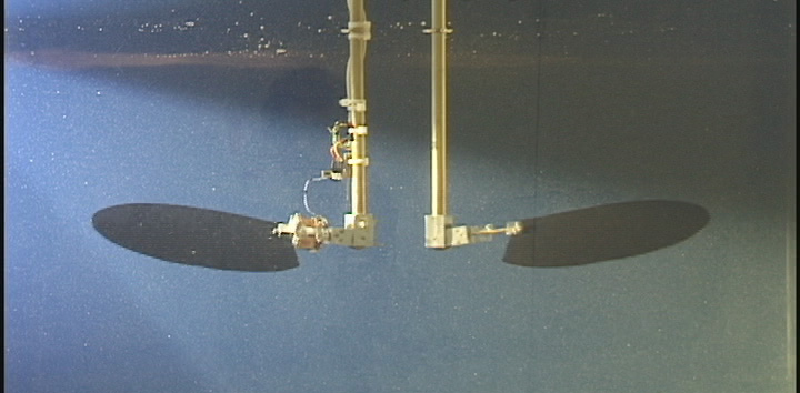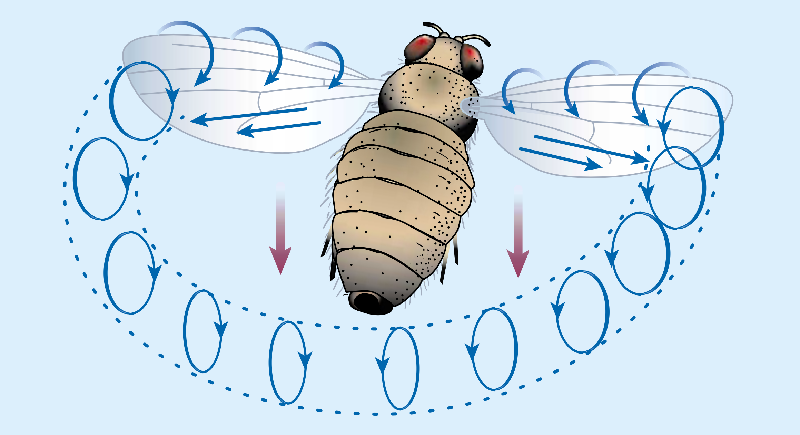Initial efforts to understand insect flight got off to a bad start. Calculations over 80 years ago showed that the bumblebee’s flight was impossible because their wings are too small and their speed too slow to generate enough lift to keep their plump body in the air. The flaw in this argument was to assume that the aerodynamic principles of airplanes and birds apply to bees and flies, when in fact insects employ a completely unique flight strategy.
FT Muijres et al., Science 344, 172 (2014)
This computer model, based on a video of real flies, shows that their wings move back and forth, not up and down.
The movement that insects use is closer to swimming or treading water than what we normally think of as flying. Instead of flapping up and down like a bird, insects move their wings back and forth. During the forward stroke, the wings are tilted about 45 ° with respect to the horizontal, which forces the air downward, thereby exerting an upward force or lifting on the insect. During the backward stroke, the wings are rotated to 135 ° so that they continue to press on the air and create lift.
A large wing pitch or “angle of attack” is catastrophic for an airplane. If it bumps up too steeply, it suddenly loses all lift and quickly falls, an event known as an aerodynamic stall. The key takeaways that explain why insects don’t falter come from robotic depictions of insects like the Robofly from Dickinson’s lab in the 1990s [1] and the flapper, created by Charlie Ellington of Cambridge University in the UK [2]. These mechanical models were much larger than real insects, but researchers used tricks to reproduce insect flight conditions. For example, the Robofly worked with mineral oil, which mimicked the sticky airflow of a small insect. The teams also flapped their robot wings more slowly to make it easier to visualize the fluid movement.
G. Lauder, Nature 412, 688 (2001)
This is the Robofly that Dickinson and colleagues use to uncover the fluid forces on insect wings.

G. Lauder, Nature 412, 688 (2001)
This is the Robofly that Dickinson and colleagues use to uncover the fluid forces on insect wings. ×
The robot experiments resulted in tiny whirlwinds, so-called leading edge eddies, which generate a negative pressure that “sucks” the wing upwards so that stalling is avoided. In addition, the researchers were able to measure the forces acting on the wings to find out how insects can fly in different directions by changing their flapping behavior. “Robots were extremely important for studying the aerodynamics of flying insects,” says biologist Florian Muijres from Wageningen University in the Netherlands.
This early robot work helped explain why insects adopted their unique flight strategy. Bird-like flapping – up and down at a small angle of attack – would only create enough lift for an inch-sized insect if it flapped its wings extremely quickly. However, bumblebees already flutter 250 times per second. Mosquitoes flutter 600 times per second. “Insects are reaching a limit in how fast they can flap their wings,” says Dickinson. They compensate for this limit of flapping by tilting their wings at a high angle of attack that provides more lift than birds can produce. The disadvantage of this high incline is greater air resistance or drag. In fact, insects get stuck with a lift to drag ratio of only about one, which is about 10 times less than that of birds and 100 times less than that of airplanes. “Insects are ridiculously inefficient when flying machines,” says Dickinson. “As a result, they only burn fuel, which makes them hungry all the time.”

G. Lauder, Nature 412, 688 (2001)
The flow of air that ripples over the leading edge of an insect’s wing creates what is known as a leading edge vortex. The low pressure in the core of the vortex increases the buoyancy. (Red arrows indicate that the wing movement is pushing the air down.)

G. Lauder, Nature 412, 688 (2001)
The flow of air that ripples over the leading edge of an insect’s wing creates what is known as a leading edge vortex. The low pressure in the core of the vortex increases the buoyancy. (Red arrows indicate that air is being pushed down by the wing movement.) ×









